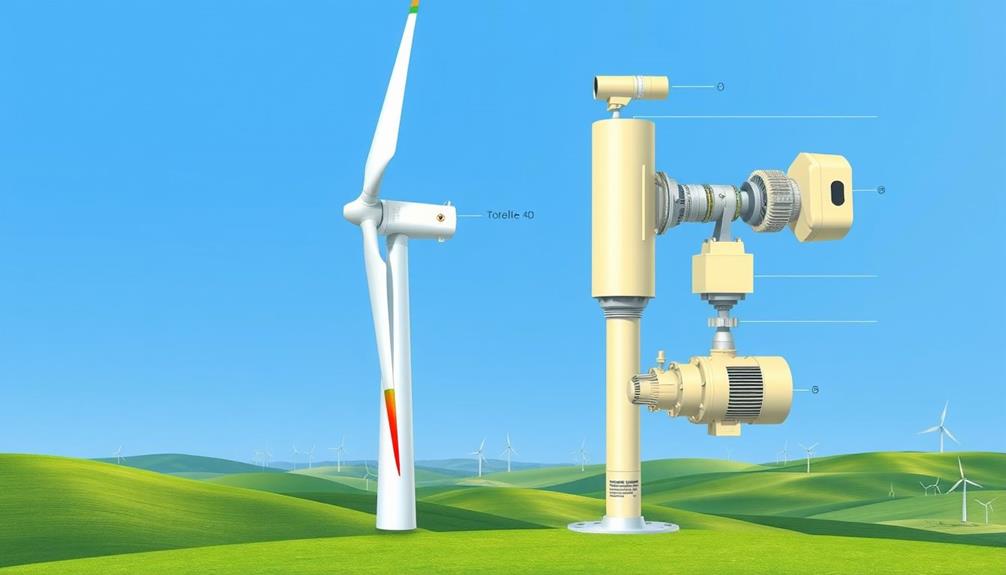To lubricate a wind turbine, you typically need around 80 gallons of oil for best performance and longevity. This oil helps guarantee the smooth operation of these renewable energy giants. And if you're interested in learning more about the top lubricants, monitoring oil conditions, and sustainability challenges in wind energy, there's a wealth of valuable information to explore further.
Key Takeaways
- Wind turbines typically require around 80 gallons of oil for lubrication.
- A large wind farm with 150 turbines needs about 12,000 gallons annually.
- Approximately 304,000 gallons of oil are needed to power a city like New York.
- PAO synthetic oil is commonly used for wind turbine lubrication.
- Proper oil quantity maintenance is crucial for wind turbine longevity.
Oil Quantity for Wind Turbines
Wind turbines require a significant amount of oil for lubrication, with a typical turbine containing around 80 gallons of oil. This oil quantity plays a vital role in the maintenance and proper functioning of wind turbines.
For large wind farms with 150 turbines, the total oil needed for maintenance can escalate to approximately 12,000 gallons annually. To put this into perspective, to power a city like New York, a staggering 304,000 gallons of oil would be required for wind turbine lubrication alone.
The oil used in these turbines is often PAO synthetic oil, a specialized lubricant derived from crude oil. Without this lubrication, the moving parts within the turbines would experience excessive wear, leading to decreased efficiency and potentially costly repairs.
Ensuring the proper oil quantity is maintained is essential for the longevity and effectiveness of wind turbine operations.
Optimal Lubricants for Wind Turbines

Synthetic oils are the preferred lubricants for wind turbines due to their superior properties compared to mineral-based alternatives. When it comes to wind turbine lubricants, here are a few key aspects to take into account:
- Gearbox Lubrication:
Synthetic oils excel in gearbox lubrication by providing lower pour points and a higher viscosity index, essential for maintaining peak performance and preventing component wear.
- Ideal Oil Fill Volume:
Wind turbine gearboxes are typically filled to around 60% of their capacity with synthetic oils to guarantee efficient operation and sufficient lubrication for components like the pitch gear, open gear, and yaw gear.
- Maintenance Practices:
Regular oil changes are essential for wind turbines, with the frequency varying based on oil condition and manufacturer recommendations. In addition, flushing and cleaning the gearbox may be necessary when switching to new synthetic oils to uphold efficiency and prolong the turbine's lifespan.
Importance of Lubrication in Wind Energy

Proper lubrication remains a critical factor in guaranteeing the efficiency and longevity of wind energy systems. Wind turbines heavily rely on lubricants to protect crucial components like gearboxes, pitch gears, open gears, and yaw gears.
The use of the right lubricants plays a pivotal role in preventing wear and tear, which ultimately reduces downtime and ensures peak operation efficiency. By utilizing the appropriate oils, wind turbine maintenance becomes more cost-effective and reliable, promoting overall turbine productivity.
This emphasis on lubrication is fundamental in sustaining renewable energy production. It guarantees that wind turbines operate at peak performance levels, meeting the significant energy demands efficiently. Investing in proper lubrication for wind turbines not only enhances their reliability but also contributes to the long-term success of wind energy as a sustainable power source.
Lubrication is a cornerstone in the maintenance and operation of wind turbines, ensuring they function smoothly and effectively throughout their lifespan.
Monitoring Wind Turbine Oil Conditions
Monitoring the condition of oil in wind turbine gearboxes is necessary for ensuring peak performance and preventing potential failures.
To effectively manage gearbox oil in wind turbines, consider the following:
- Fluid Testing: Regular sampling and fluid testing are essential practices in wind turbine maintenance. These tests identify wear issues early on, preventing catastrophic failures and optimizing performance.
- Sensor Technology: In-line sensors play an important role in monitoring oil conditions. They assess cleanliness, conductivity, and other key indicators to determine the lubrication efficiency of the gearbox oil.
- Cost-Saving Measures: Monitoring oil conditions can help determine the best oil drain intervals. By extending these intervals based on oil condition analysis, costs and resources can be saved while ensuring early failure prevention in wind turbines.
Sustainability Challenges in Wind Energy

Wind energy faces significant sustainability challenges, particularly concerning the disposal of non-recyclable wind turbine blades and the ongoing impact of oil consumption on environmental sustainability.
Wind turbine blades, which aren't easily recyclable, present a pressing issue as special landfills are filling up with decommissioned blades. The accumulation of these blades raises concerns about their long-term disposal and environmental impact.
Additionally, the oil consumption required for wind energy operations poses a sustainability challenge, as it contributes to the industry's environmental footprint. Furthermore, the need for clear-cut land for wind farms raises additional environmental and sustainability concerns within the renewable energy sector.
Addressing these sustainability challenges is vital for the long-term viability of wind energy and requires innovative solutions to minimize the environmental impacts of wind turbine operations and maintenance. By tackling these issues, the industry can work towards a more sustainable future for renewable energy.
Frequently Asked Questions
How Many Barrels of Oil Does a Wind Turbine Replace?
A wind turbine can replace about 5,000 barrels of oil over its operational lifetime. By generating clean, renewable energy, wind turbines notably decrease reliance on traditional oil-based energy sources, contributing to a sustainable future.
How Much Gear Oil Is in a Wind Turbine?
To keep a wind turbine running smoothly, it typically contains 80 gallons of gear oil. Maintenance is important, with larger wind farms requiring thousands of gallons annually. Gear oil is essential for efficient energy production.
How Often Do Wind Turbines Need to Be Greased?
You should grease wind turbines every 6 to 12 months to maintain proper lubrication. Following manufacturer guidelines and monitoring operating conditions is key. Regular greasing reduces friction, heat, and wear, ensuring efficient turbine operation and longevity.
What Kind of Oil Does a Wind Turbine Use?
You'll find that wind turbines use approximately 80 gallons of high-performance PAO synthetic oil derived from crude oil for lubrication. Ensuring proper oil usage is vital for reliability, peak performance, and cost-effective renewable energy production.
What is the Importance of Oil in the Functioning of a Wind Turbine?
The oil content in wind turbines is crucial for their functioning. It helps lubricate the components to reduce friction and prevent wear and tear. This prolongs the lifespan of the turbine and ensures smooth operation. Regular maintenance and monitoring of the oil content are essential for optimal performance.
Conclusion
To keep your wind turbine running smoothly, make sure you have enough oil to lubricate it properly. Use the best lubricants available and regularly monitor the oil condition to prevent any potential issues.
Remember, proper lubrication is essential in maintaining the efficiency and longevity of your wind turbine.
Stay proactive in addressing sustainability challenges in wind energy to secure a greener future for generations to come.










